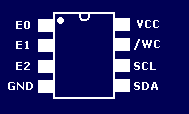en.radzio.dxp.pl
Main menu
Index
Privacy policy
Youtube channel
PCB Manufacturer
Tutorials
STM32F429I-DISCOVERY
STM32VLDISCOVERY
Code library for LCD
S1D15705
SSD1963
SED1335/RA8835
SED1520/NJU6450
SED1530/SPLC501C
KS0108/HD61202
S6B0724
T6963C
ATMEL AVR microcontrollers
HD44780 driver
1-wire driver
Delay utilities
Decoding RC5 infrared
iButton CRC computing
iButton reader
ATtiny2313 board
ATmega162 board
STMicro ST7 microcontrollers
Software I2C impementation
External I2C EEPROM memory
Projects
SPI bus sniffer
I2C bus sniffer
1-wire sniffer
AVR910 programmer
Software
Bitmap converter for LCD
Modbus Master Simulator
Why external EEPROM memory?
Sometimes small internal EEPROM memory in ST7 devices is not enough
to application requirements. By connecting external EEPROM chips we
can expand this small non-volatile memory space. Most popular
EEPROMs are 24Cxx I2C bus memories.
We are use software I2C master routines from page : Software I2C master implementation
Pinout of M24C64 from STMicroelectronics (and other M24Cxx memories) is shown on below picture:

Pins E0..E2 are chip enable inputs. In dependency of this pins state memory device slave address can be different. Look at below table:

It can be up to eight different address of M24C64 memory, so we can connect up to eight of M24C64 memory devices to one I2C bus. Device select address is shown on below picture :

Write single byte to EEPROM memory
Write single byte to specified address in EEPROM memory is realized
by a
M24C64_WriteByte routine. Before call to m24DstAddr variable write
destination address (memory cell address in M24C64 device) and to A
register write byte to write in EEPROM memory.
Byte write sequence is shown on below picture :

Source code of M24C64_WriteByte routine is shown below :
Source code of M24C64_WriteByte routine |
| ;------------------------------------------------------------------------- ; Parameters ; m24DstAddr : destination address ; A : data to write ;------------------------------------------------------------------------- .M24C64_WriteByte PUSH A ; store data on stack CALL I2C_Start ; START LD A, #M24WRITEADDR ; CALL I2C_Write ; address of M24C64 LD A, {m24DstAddr + 0} ; CALL I2C_Write ; MSB of memory address LD A, {m24DstAddr + 1} ; CALL I2C_Write ; LSB of memory address POP A ; restore data from stack CALL I2C_Write ; data write CALL I2C_Stop ; STOP RET |
Write buffer to EEPROM memory
When we want write many bytes from continuous memory space to
EEPROM memory write byte-by-byte is very ineffective. M24C64 memory
device can write up to 32 bytes in one programming cycle. Page write
sequence is shown on below picture :

Source code of M24C64_WriteBuffer routine is shown below:
Source code of M24C64_WriteBuffer routine |
| ;------------------------------------------------------------------------- ; Parameters ; m24SrcAddr : source address (buffer in RAM) ; m24DstAddr : destination address (in EEPROM) ; A : buffer size (max. 32 bytes) ;------------------------------------------------------------------------- .M24C64_WriteBuffer LD m24Count, A ; number of bytes to write CALL I2C_Start ; START LD A, #M24WRITEADDR ; CALL I2C_Write ; address of M24C64 LD A, {m24DstAddr + 0} ; CALL I2C_Write ; MSB destination address LD A, {m24DstAddr + 1} ; CALL I2C_Write ; LSB destination address CLR X ; M24C64_WriteBufferLoop LD A,([m24SrcAddr.w],X) ; read from buffer CALL I2C_Write ; write to EEPROM INC X ; X++ CP X, m24Count ; if last byte? JRNE M24C64_WriteBufferLoop ; if not, jump to loop CALL I2C_Stop ; STOP RET |
Read single byte from EEPROM memory
Read single byte from M24C64 EEPROM memory is realized by a
M24C64_ReadByte routine. Before call this routine place in
m24SrcAddr address of read byte in memory. Single byte read sequence
is shown on below picture:

Source code of M24C64_ReadByte routine is shown below:
Source code of M24C64_ReadByte routine |
| ;------------------------------------------------------------------------- ; Parameters ; m24SrcAddr : source address (in EEPROM) ; Return value ; A : read data ;------------------------------------------------------------------------- .M24C64_ReadByte CALL I2C_Start ; START LD A, #M24WRITEADDR ; CALL I2C_Write ; slave address LD A, {m24SrcAddr + 0} ; CALL I2C_Write ; MSB source address LD A, {m24SrcAddr + 1} ; CALL I2C_Write ; LSB source address CALL I2C_Start ; repeated START LD A, #M24READADDR ; CALL I2C_Write ; slave address + Read SCF ; NOACK CALL I2C_Read ; data read CALL I2C_Stop ; STOP RET |
Read buffer from EEPROM memory
Similar to write more than one byte, there are possibility to
read more than one bytes from EEPROM memory. Continuous read
sequence is shown on below picture :

Source code of M24C64_ReadBuffer routine is shown below:
Source code of M24C64_ReadBuffer routine |
| ;------------------------------------------------------------------------- ; Parameters ; m24SrcAddr : source address ; m24DstAddr : destination address ; A : buffer size (min. 2) ;------------------------------------------------------------------------- .M24C64_ReadBuffer DEC A ; LD m24Count, A ; buffer size - 1 CALL I2C_Start ; START LD A, #M24WRITEADDR ; CALL I2C_Write ; slave address LD A, {m24SrcAddr + 0} ; CALL I2C_Write ; MSB of source adress LD A, {m24SrcAddr + 1} ; CALL I2C_Write ; LSB of source address CALL I2C_Start ; START LD A, #M24READADDR ; CALL I2C_Write ; slave address + R CLR X M24C64_ReadBufferLoop RCF ; ACK CALL I2C_Read ; read byte from EEPROM LD ([m24DstAddr.w],X), A ; write to bufer INC X ; X++ CP X, m24Count ; is one before last byte? JRNE M24C64_ReadBufferLoop ; if not jump to loop SCF ; NOACK CALL I2C_Read ; read last byte from EEPROM LD ([m24DstAddr.w],X), A ; write to buffer CALL I2C_Stop ; STOP RET |
Download
M24C64.asm